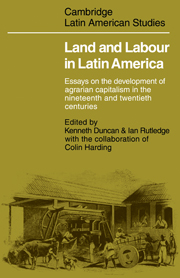 Land and Labourin Latin America
Land and Labourin Latin America Book contents
- Frontmatter
- Contents
- List of tables
- List of figures
- List of maps
- Acknowledgements
- 1 Introduction: patterns of agrarian capitalism in Latin America
- PART I THE TRANSITION FROM TRADITIONAL HACIENDA TO CAPITALIST ESTATE
- 2 Hacienda profits and tenant farming in the Mexican Bajío, 1700–1860
- 3 Landlord, labourer, and tenant in San Luis Potosí, northern Mexico, 1822–1910
- 4 Land and labour in rural Chile, 1850–1935
- 5 The development of the Chilean hacienda system, 1850–1973
- 6 Relations of production in Andean haciendas: Peru
- 7 The formation of the coffee estate in nineteenth-century Costa Rica
- PART II THE DEVELOPMENT OF A PLANTATION ECONOMY WITH LABOUR RECRUITMENT FROM HIGHLAND PEASANT COMMUNITIES
- PART III THE DEVELOPMENT OF COMMERCIAL AGRICULTURE USING EUROPEAN IMMIGRANT LABOUR
- PART IV THE TRANSITION FROM SLAVE PLANTATION TO CAPITALIST PLANTATION
- PART V POSTSCRIPT
- Glossary of Spanish and Portuguese terms used in the text
- Weights and measures
- Notes on contributors
- Indexes Subjects
- Authors
6 - Relations of production in Andean haciendas: Peru
Published online by Cambridge University Press: 07 May 2010
- Frontmatter
- Contents
- List of tables
- List of figures
- List of maps
- Acknowledgements
- 1 Introduction: patterns of agrarian capitalism in Latin America
- PART I THE TRANSITION FROM TRADITIONAL HACIENDA TO CAPITALIST ESTATE
- 2 Hacienda profits and tenant farming in the Mexican Bajío, 1700–1860
- 3 Landlord, labourer, and tenant in San Luis Potosí, northern Mexico, 1822–1910
- 4 Land and labour in rural Chile, 1850–1935
- 5 The development of the Chilean hacienda system, 1850–1973
- 6 Relations of production in Andean haciendas: Peru
- 7 The formation of the coffee estate in nineteenth-century Costa Rica
- PART II THE DEVELOPMENT OF A PLANTATION ECONOMY WITH LABOUR RECRUITMENT FROM HIGHLAND PEASANT COMMUNITIES
- PART III THE DEVELOPMENT OF COMMERCIAL AGRICULTURE USING EUROPEAN IMMIGRANT LABOUR
- PART IV THE TRANSITION FROM SLAVE PLANTATION TO CAPITALIST PLANTATION
- PART V POSTSCRIPT
- Glossary of Spanish and Portuguese terms used in the text
- Weights and measures
- Notes on contributors
- Indexes Subjects
- Authors
Summary
This paper presents some tentative conclusions based on the archives of a few expropriated haciendas. The material so far collected in Lima filled five or six lorries, and they will allow several books to be written by several people. A large part of the new archive consists of account books. A much smaller and sometimes very juicy part (perhaps one quarter of a lorry-load in all) consists of correspondence between hacienda managers and landowners, or hacienda managers and comunidad authorities, and so on. All this either has been catalogued or is in the process of being catalogued. It belongs almost totally to the twentieth century. A great digestive capacity will be needed to work through this material. One also needs a stomach as strong as that of a llama (the Andean cameloid), since the diet includes massacred, beaten-up, and blacklisted Indians. However, one of my tentative conclusions is that the Indians’ resistance to the expansion of the haciendas made landowners behave carefully, if not kindly.
A relevant consideration, in order to properly assess the value of the records collected in Lima, is that those haciendas which kept many records are surely not typical, modal haciendas, but they are nevertheless crucial to an understanding of the efforts made at rationalization and the resistance they provoked. One might argue that some landowners were able to expand their haciendas and rationalize their labour systems only because other, more traditional, and wiser hacendados did not follow suit in this dangerous disruption of the rules of the game.
- Type
- Chapter
- Information
- Land and Labourin Latin AmericaEssays on the Development of Agrarian Capitalism in the nineteenth and twentieth centuries, pp. 141 - 164Publisher: Cambridge University PressPrint publication year: 1978
- 1
- Cited by


